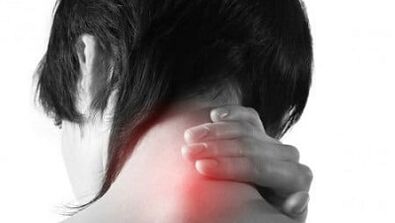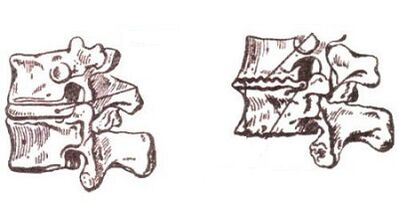
How to cure osteochondrosis of the cervical spine and what is the cause of its appearance?This problem is worried about those women and men who are forced to solve problems with health problems every day: from annoying neck discomfort to severe headaches and other problems.
The main reason for the development of the disease is to reduce the distance between the vertebrae due to the destruction of cartilage between them.
For reference.Osteochondrosis in the cervical spine is a degenerative-dystrophic progressive disease, widely used due to the excessive mobility of the vertebrae in the neck.The osteochondrosis of the spine causes uncontrolled physical activity, injuries and weak muscle corset.All these causes ultimately lead to the development of cervical osteochondrosis.
Etiology of the disease
The main reason why osteochondrosis of the cervical develops is to reduce the distance between the vertebrae due to the gradual destruction of cartilage between them.Each unsuccessful position provokes the replacement of the vertebrae, and the vessels and nerves are pressed.
The most characteristic causes of the development of osteochondrosis:
- Genetic predisposition to the disease.
- Excess weight and metabolic disorder.
- Frequent infections, intoxication of the body.
- Poor, less eating with the minimum intake of vitamins, traces of elements and fluids, leading to deformity of the vertebrae.
- Spinal curvature, injuries, bruises, fractures, standing of the posture (osteochondrosis of the original department).
- Flat legs and instability in the spinal segments, including in the bodies of the cervical vertebrae.
- Work associated with lifting weights or frequent changes in body position (flicker, rotation).
- A sedentary lifestyle, poor ecology.
- Performing hard work with undeveloped bone muscle system that leads to the deformation of the vertebrae.
- Long -term forced position of the body, nervous overvoltage and stress.
- "Wrong" sleep pillows that change the position of the vertebrae of the cervical region.

A sedentary lifestyle increases the risk of disease.
It is important to remember that the onset of osteochondrosis cannot be noticed.Therefore, with any unpleasant sensations in the neck, you need to contact a specialist in a timely manner.
The following causes of osteochondrosis are theoretical, but are in practice:
Involuntarily
They are associated with impaired tissue trophies during aging of the body, which is used mainly to the intervertebral discs and vertebrae, where a large number of blood vessels pass.
Hormonal
Along with hormonal disorders, dystrophic changes (osteochondrosis) occur in the body, including the intervertebral discs in the process.
Vascular
They are observed in the event of a violation of the segmental circulation and the metabolism of water.Subsequently, dystrophic changes in tissues and organs, including osteochondrosis of the neck, are formed.
Infectious
The infection that occurs in the intervertebral discs of the cervical spine and the surrounding tissues disrupts the diffusion of the lymphatic fluid and leads to a change in the tissues and cervical vertebrae in the diet.This is what causes degenerative changes in the spine inherent in osteochondrosis.
Bioelectricity
The inversion of the vector forces of the bioelectric fields into the intervertebral disc arises due to injuries, overload and temperature changes.Eventually, osteochondrosis of the spine occurs and most often polysegenic.
Mechanical
Injuries and significant overload of the spine lead to disruption of the integrity of the fibrous ring and the dystrophy of the cervical spine discs.
Anomaline
This refers to congenital abnormalities of the spine and its individual structural parts.At the same time, the healthy vertebrae of the cervical region acquire a double load, leading to their rapid wear and development of osteochondrosis of the neck.
Functional
Primary pathological changes refer to muscle tissue due to congenital or acquired factors.Uneven muscle contraction in a plane causes osteochondrosis of the neck.
Stages of the disease
Cervical osteochondrosis has four degrees of disease.They are characterized by special symptoms and changes that affect the cervical region:

- In the 1st degreeDamage to the nucleus of the pulp occurs as a result of a violation of the metabolic processes.It becomes less elastic, dries and does not cope with the loads in the cervical spine.In the 1st degree, the patient does not experience pain, only occasionally stiffness occurs.Treatment at this stage of damage to the cervical region is the most effective, a simple massage course helps.
- At 2 degreesDamage to the fibrous ring occurs, the micro -spots are formed from the lateral and posterior surfaces of the vertebra disc.The patient with pathology to this extent begins to experience neck pain.
- At 3 degreesThe bone structure undergoes changes, the fibrous ring is deformed and torn.All close tissues, nerves and blood vessels suffer, the lack of air, the noise in the ears and the head is felt by the patient.Osteochondrosis of the neck at 3 degrees is characterized by the appearance of sick pain in the back of the head, rotation of the head becomes very difficult.
- At 4 degreesThere is a degenerative recovery of the spine, the process lasts for about a year.There is a change in bone tissue growth in a deformed vertebra (it grows in the width).The diseased spine gradually becomes a static painful frozen bone column.
Only timely prevention of osteochondrosis will help prevent the disease from developing.
The main manifestations of osteochondrosis, including polysegmental, are found in 35 years, and the more agents are human, the more often patients complain of a specialist in neck pain.The most common causes of pathology are in our time a long stay in the computer and driving a car.Such forced positions of the spine lead to destabilization in the spine.
Clinical manifestations
The symptoms of cervical osteochondrosis have a pronounced personality and differ from the symptoms of the disease in another spine.This is due to the characteristics of the structure of the vertebrae and the fact that they are much closer than in the thoracic and lumbar regions.That is why, even with the most iconic pathologies, cervical osteochondrosis feels faster.
The following signs of osteochondrosis of the cervical spine are the most characteristic:
Pain
The first symptom that gives a person to know about the beginning of the problem in the neck.It can be located: neck, back of the head, shoulder, upper arm.If the spine of the nerve is involved in the pathological process that is "responsible" for the innervation of the upper arm, there are unpleasant sensations that resemble lifting weights.The pain in the back of the head occurs with severe cramps of the neck muscles attached to the back bone.In addition, blood flow is impaired, which provokes the appearance of symptoms of poor blood supply to the brain.
Weakness in the hands

Such a symptom is caused by damage to the nerve root and fibers that perform the motor function and innervate the muscles of the hands.
The symptom of the disease can be weakness and poor sensitivity in the hands.
Bad sensitivity
This symptom is explained by damage to sensitive nerve fibers that innervate the skin.
Crown and restriction of neck mobility
These are characteristic symptoms showing the "drying" of the intervertebral disc.In addition, bone tissue growth also occurs in small joints located between the cervical vertebrae.
Bad coordination
Symptoms indicate that cervical osteochondrosis progresses.The nerves and the spinal artery are squeezed and when the fibrous tissue is formed and the displacement of the vertebrae, the blood flow worsens, leading to the appearance of symptoms showing poor blood supply to the brain and brain.In severe cases, the following symptoms develop: hearing loss, tongue numbness, vision problems.
As you can see, osteochondrosis is by no means a harmless disease, which symptoms eloquently speak eloquently.
The principles of therapeutic measures
The treatment of cervical osteochondrosis in men and women is based on the stopping of all symptoms of the disease and the elimination of the causes of the osteochondrosis of the cervical cervical.The symptoms are mainly associated with compression of nerve fibers and blood vessels, therefore it is primary to eliminate edema, inflammation and restoration of normal blood supply.Cervical osteochondrosis in the initial stages is successfully withdrawn when physiotherapy exercises participate when the drug does not resort to help.
The success of the treatment depends only on the teamwork of qualified doctors.
With the development of cervical osteochondrosis, the local therapist, who is almost always addressed primary, helps a little.As a rule, its treatment is only symptomatic, but it is not able to fully detect and eliminate the cause of the disease.Therefore, the success of the treatment depends only on the teamwork of qualified doctors: preterm, neurologist, surgeon, physiotherapist and massage therapist.

The treatment of osteochondrosis of the cervical region is important to start at a very early stage, otherwise in 2-3 stages there is a strong change in the vertebrae and the treatment will be long, difficult and not always effective.The basis for the treatment of neck problems is the administration of medicines, physiotherapy, massage and therapeutic exercises.
Preparations used for cervical osteochondrosis:
- Nsaid.
- Vitamin preparations.
- Medicines that improve blood flow.
- Mussorelaxants.
- Chondroprotectors.
The treatment of cervical osteochondrosis is performed using the following physiotherapy methods:
- Ultrasound (relieves pain, improves metabolic processes).
- Electrophoresis (delivery of medicines to a problem area).
- Laser therapy (relieves inflammation and improves blood circulation).
- Magnetotherapy (relieves tissue edema).
Cervical osteochondrosis should not be underestimated.Very often, men and women have a slight neck discomfort, especially with a long sitting on the computer or in another forced position.You do not need to take medication at the outset, but try to remove the cause or periodically do easy loading (at work or at home).Indications for surgical treatment: lack of conservative treatment (medicine, physiotherapy, gymnastics), persistent pain, myelopathy, disruption of cerebral circulation.






















